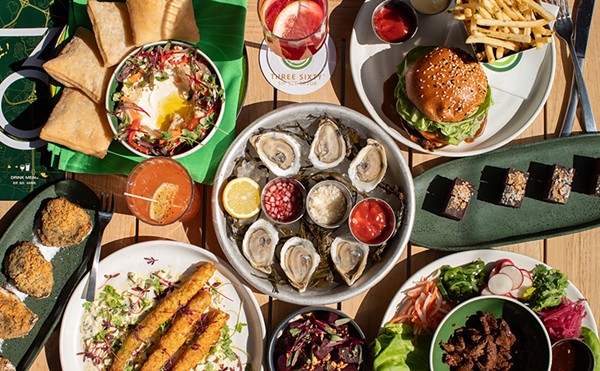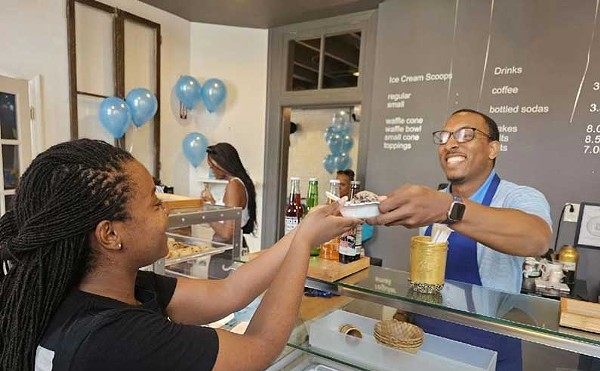The opening of Sqwires should lay to rest any lingering skepticism about how cosmopolitan St. Louis can be when we put our minds to it. The restaurant is an urban showpiece, the product of a singular bargain between noble aspirations and cold cash. The nearly $15 million renovation of the old Western Wire Products factory is what historical preservationists call an adaptive reuse project. The remaining square footage in the complex is being converted into banquet facilities and 80 loft apartments.
The site is in Lafayette Square, an up-and-coming historic district that gives Sqwires several advantages: The neighborhood has a contingent of devoted residents who will dine and shop at the new restaurant and market; the lovely Gilded Age mansions and Victorian park will draw suburban customers; and the area is a convenient lunch destination for downtown office workers. Similar projects have transformed historic quarters from the LoDo (lower downtown) warehouse district in Denver to the Bricktown district in Oklahoma City. (The frequency with which these cities' newspapers make grandiose allusions to a "renaissance" suggests that St. Louis isn't the only burg suffering from image insecurity.)
Sqwires has wisely departed from the usual tedious recipe for furbishing a hip city restaurant, which goes something like this: Suspend pinpoint spotlights from the open-ductwork ceiling. Hang four or five vintage ad posters (in French, naturally) on the inevitable exposed-brick walls. Rent some white table linens, light a few candles, place an exotic spray of flowers near the hostess stand and -- voilà! -- generic urban dining room model 2A is ready for business. But it takes more than formulaic city chic to attract repeat customers. Instead of visiting Deck the Walls, owner Bethany Budde hired the Johannes/Cohen architectural firm to revamp the factory. Designer Tom Cohen divided the space into zones: A long corridor of tables, designated as the smoking section, neatly separates the retail market and deli from the dining room. To remind patrons of the building's original function, he retained some of the manufacturing equipment -- pulleys that once powered huge belts hang from the ceiling like colossal fishing tackle. A cold-rolled-steel furnace has been installed to make the high-ceilinged dining room more intimate. It's a recessed niche set about waist high, like a fireplace that has no mantelpiece. A rectangular inset of carpeting warms the cement floor and keeps noise in check. Button-backed lipstick-red banquettes have a loungey Rat Pack glamour, and abstract charcoal sketches mounted on the exposed-brick walls give the room a techno edge.
Funky restaurants such as this one attract young servers, who can be too offhand and green. Our server, however -- the same one on both visits -- was so serious about dining that she chided us for bringing work to the table, urging us to enjoy the meal without distractions. (Her point was well taken, though we contend that a paying customer may do as he pleases if he's not a nuisance to other diners.) She was refreshingly knowledgeable about the wine list, and she pointed us toward the dishes she liked best.
Bryan Carr was Sqwires' executive chef when we visited, but he departed last week in an abrupt shakeup. He has been replaced by Brian Hale, formerly of Harry's on Market. The restaurant's menu, which highlights seafood, will not change until January.
Now, the term "fresh seafood" has become so clichéd that our earnest server felt compelled to attest, "Our seafood really is the freshest you can get in St. Louis -- we're not just saying that." She was right. The menu capitalizes on the fall oyster season in an appetizer of oysters three ways -- raw, Rockefeller and barbecued, with a fruity-sweet caramelized-onion marmalade. The shellfish appear again in a restrained entrée of oyster stew, which is more like a silky soup than a chunky chowder. The dozen-or-so shucked whole oysters in the stew were creamy and soft but not flabby, with a mineraly sea-spray finish.
The simple, spirited food keeps pace with the restaurant's dynamic design. A beautifully striated piece of sea bass is arranged on folds of sautéed spinach and steeped in a transparent broth flecked with threads of saffron. The fish's flavor is lifted with a few diced tomatoes, briny kalamata olives and a chiffonade of basil. Short ribs, served with warm polenta, receive a similar treatment. The pork is braised for three hours, a process that breaks down the meat and bathes it in its own juices. The dish is punctuated with olives, tomatoes and rosemary. A potato-pancake appetizer is prepared like Danish rösti potatoes -- the grated bits are shaped into a disk and sautéed in a hot skillet, though the restaurant uses oil in lieu of butter. The crisp round is cut into triangles and plated with baked apple slices, goat cheese, arugula and caramelized onions.
A few dishes were dragged down in an undertow of blandness. Spinach soup with crab was like a wad of warm paper pulp. It's hard to believe that anyone in the kitchen actually tasted it. The only flavor in the bowl came from the spoonful of crabmeat. We couldn't even detect salt, and a garnish of tomato relish had apparently been forgotten. The Sqwires salad -- green beans, endive and other vegetables tossed in a vinaigrette -- was crunchy but had no more allure than plain iceberg lettuce.
Desserts were fickle, and no specials were offered, even though the restaurant employs a pastry chef. The pear tart had a dark, overbaked crust as dry as a mouthful of saltines. The tough pastry shell was a tip-off that the tart was probably several days old or perhaps had been frozen and thawed. The accompanying pear sorbet captured the very essence of ripe fruit, but the stinting portion was hardly enough to moisten the desiccated tart. The other ice creams and sorbets also seemed to have been doled out with a melon baller. Spice cake -- parched sheet cake punched into a deflated circle using a biscuit cutter -- was painted with a gummy quince compote that bore an unfortunate resemblance to golden fish roe. Chocolate blackout cake, a nauseating name worthy of a place on Shoney's menu, was indeed chocolatey but had little else to recommend it. Its accompaniment, raspberry ice cream, was unavailable. The cake was served instead with pear sorbet, a mismatched flavor partner. The most appealing dessert was tropical bread pudding, a puffy, chewy, eggy wedge garnished with a divot of coconut sorbet.
As we polished off the bread pudding, we surveyed the smartly dressed and coiffed customers, who looked no different from diners in SoHo and Wrigleyville and Pioneer Square. Then we spotted a young man in a snap-front shirt escorting a gal wearing an enormous pink hair scrunchie. Even with Sqwires in town, we haven't gotten too big for our britches just yet.





